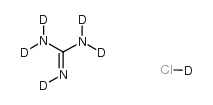Guanidine-d5 hydrochloride
Modify Date: 2024-01-16 17:32:07

Guanidine-d5 hydrochloride structure
|
Common Name | Guanidine-d5 hydrochloride | ||
|---|---|---|---|---|
| CAS Number | 108694-93-5 | Molecular Weight | 101.56800 | |
| Density | 1.69g/cm3 | Boiling Point | 132.9ºC at 760 mmHg | |
| Molecular Formula | CClD6N3 | Melting Point | 185-189ºC(lit.) | |
| MSDS | Chinese USA | Flash Point | 34.2ºC | |
| Symbol |

GHS07 |
Signal Word | Warning | |
Use of Guanidine-d5 hydrochlorideGuanidine-d5 (hydrochloride) is the deuterium labeled Guanidine hydrochloride[1]. Guanidine hydrochloride (Guanidinium chloride) a strong chaotrope, is also a strong denaturant of proteins[2][3]. |
| Name | Guanidine-d5 deuteriochloride |
|---|---|
| Synonym | More Synonyms |
| Description | Guanidine-d5 (hydrochloride) is the deuterium labeled Guanidine hydrochloride[1]. Guanidine hydrochloride (Guanidinium chloride) a strong chaotrope, is also a strong denaturant of proteins[2][3]. |
|---|---|
| In Vitro | Stable heavy isotopes of hydrogen, carbon, and other elements have been incorporated into drug molecules, largely as tracers for quantitation during the drug development process. Deuteration has gained attention because of its potential to affect the pharmacokinetic and metabolic profiles of drugs[1]. |
| References |
| Density | 1.69g/cm3 |
|---|---|
| Boiling Point | 132.9ºC at 760 mmHg |
| Melting Point | 185-189ºC(lit.) |
| Molecular Formula | CClD6N3 |
| Molecular Weight | 101.56800 |
| Flash Point | 34.2ºC |
| Exact Mass | 101.06300 |
| PSA | 75.89000 |
| LogP | 1.14090 |
| Vapour Pressure | 8.67mmHg at 25°C |
| Index of Refraction | 1.595 |
| Symbol |

GHS07 |
|---|---|
| Signal Word | Warning |
| Hazard Statements | H302-H315-H319 |
| Precautionary Statements | P305 + P351 + P338 |
| Hazard Codes | Xn: Harmful; |
| Risk Phrases | R20/21/22 |
| Safety Phrases | 26-36 |
| RIDADR | NONH for all modes of transport |
| MFCD00144417 |
| Guanidine-d5 Hydrochloride-d |
| Guanidinium-Kation |
| guanidin*2HCl |
| guanidine dihydrochloride |